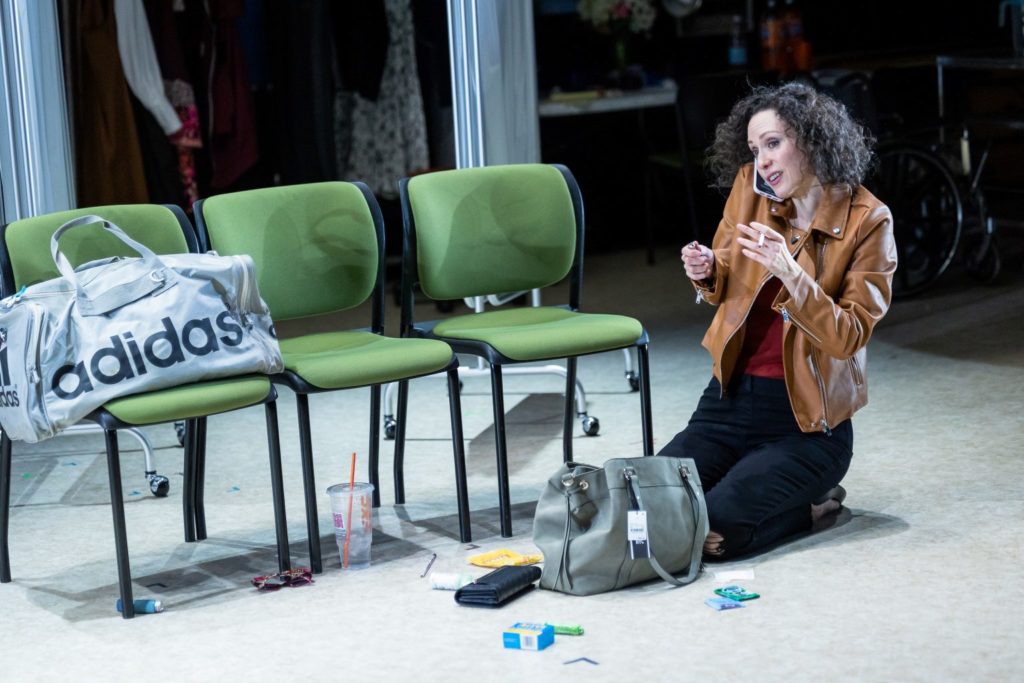Presented by SpeakEasy Stage Company
Written by Duncan MacMillan
Directed by David R Gammons
Dramaturgy by Rulas A Muñoz
Feb. 11 – March 5, 2022
Audio Description – February 19 at 8pm and February 20 at 3pm
Open Captioning – March 3 at 2pm and 7:30pm
South End / Calderwood Pavilion at the BCA
527 Tremont St.
Boston, MA 02116
SpeakEasy on Facebook
Critique by Kitty Drexel
CONTENT ADVISORY: This production contains depictions of addiction and self-harm, discussions of sexual assault, an extended strobe light sequence, herbal cigarette smoke, and loud noises.
BOSTON — A friend once told me, despite the burden mental illness can present, that the brain is trying to help. The myriad painful symptoms I and many others experience as effects of mental illness are the brain’s way of facilitating, even normalizing the abnormalities of life. Sometimes, I’d rather it not.
Just because the brain is trying to help, it doesn’t mean the brain is actually helping. It takes tremendous discipline to correct negative behaviors and toxic thoughts and to learn new ones. Failure is inevitable. If it takes a village to teach toxic patterns, it takes another village to reinforce positive ones.
SpeakEasy Stage’s People, Places & Things running at the BCA is about addiction, mental health, the theatre, and identity. Emma (Marianna Bassham in a performance that will blow your mind) is in denial. She abuses drugs to cope with her performing career, her family, and the life that happens in-between. She’s on so many drugs when she collapses on stage during a production of The Seagull, it’s a miracle she isn’t dead already.
Emma enters rehab. She tells her doctors (Debra Wise on Feb. 17), the rehab associate (Kadahj Bennett), new friend Mark (Nael Nacer), and her fellow patients that she uses drugs in order to evade the chaos of life, but she knows she’s just pretending. Emma can either do the program or piss away her time in rehab. Whether she survives once she gets out is up to her.
The cast also includes Josephine Moshiri Elwood, Parker Jennings, John Kuntz, Victor Shopov, Shanelle Chloe Villegas, Shamarke Yusuf. The ensemble work in this production is some of the best this season.
This production was rescheduled due to the COVID-19 pandemic. Casting may vary depending on actor availability from the rescheduling.

Marianna Bassham in People, Places & Things. Photo by Nile Scott Studios.
The National Institute of Mental Health says on its website, “substance use disorder (SUD) is a mental disorder that affects a person’s brain and behavior, leading to a person’s inability to control their use of substances such as legal or illegal drugs, alcohol, or medications. Symptoms can range from moderate to severe, with addiction being the most severe form of SUDs.”
SpeakEasy Stage does an excellent job of warning its audiences of the potentially triggering content in this play. Its warnings don’t take away from the experience of play. Warnings enable a viewer to make a better choice for their mental health because no one leaves this life unscathed.
People, Places & Things is well-crafted, superbly acted (Bassham, Nacer, Bennett and Wise balance high theatre with permeable vulnerability), and effectively staged. David R Gammons guided the internal, private world of mental disorder and blasted it onstage.
The hallucination scenes enacted a peak level of hyperbolic madness usually reserved for operatic performance. Gammons made the internal perspective an external experience. It was absurdly beautiful and overwhelming.

Marianna Bassham and the cast of People, Places & Things. Photo by Nile Scott Studios.
It is good that People, Places & Things discusses addiction, mental health, and the imperfect rehabilitation resources available to addicts. It is good because discussion can lead to better resources, higher success rates, and greater compassion from those outside the struggle. Survivors need those things to continue surviving.
The cast and crew of People, Places & Things have great empathy for those who are surviving addiction. There are moments when Emma lacks empathy for her shared situation in rehab. She lashes out at her doctors; she ridicules other patients; she selfishly breaks rules. These moments were played with respect for the characters and the subject.
The addictions and other disorders depicted in People, Places & Things are unique to the circumstances of its characters. One’s mental illness can differ drastically from another’s. Viewers may still find the play’s events relatable. I did.
After the performance, after leaving the BCA, I had a healthy, cathartic cry as my loving wife walked us to the T. (I was and am fine. The content advisories prepared me, and I girded my loins, as one does, appropriately.)
I discuss my own mental health on this blog. I do it to be a better activist, to destigmatize greater mental health issues, and to hopefully help others who may be suffering in silence.
This performance hit me where I live. Good performances can do that. This production may do that for you, so please be gentle with yourself.
Shatner would agree that death is a terrible excuse for self-harm. Please live to your fullest responsibly.
